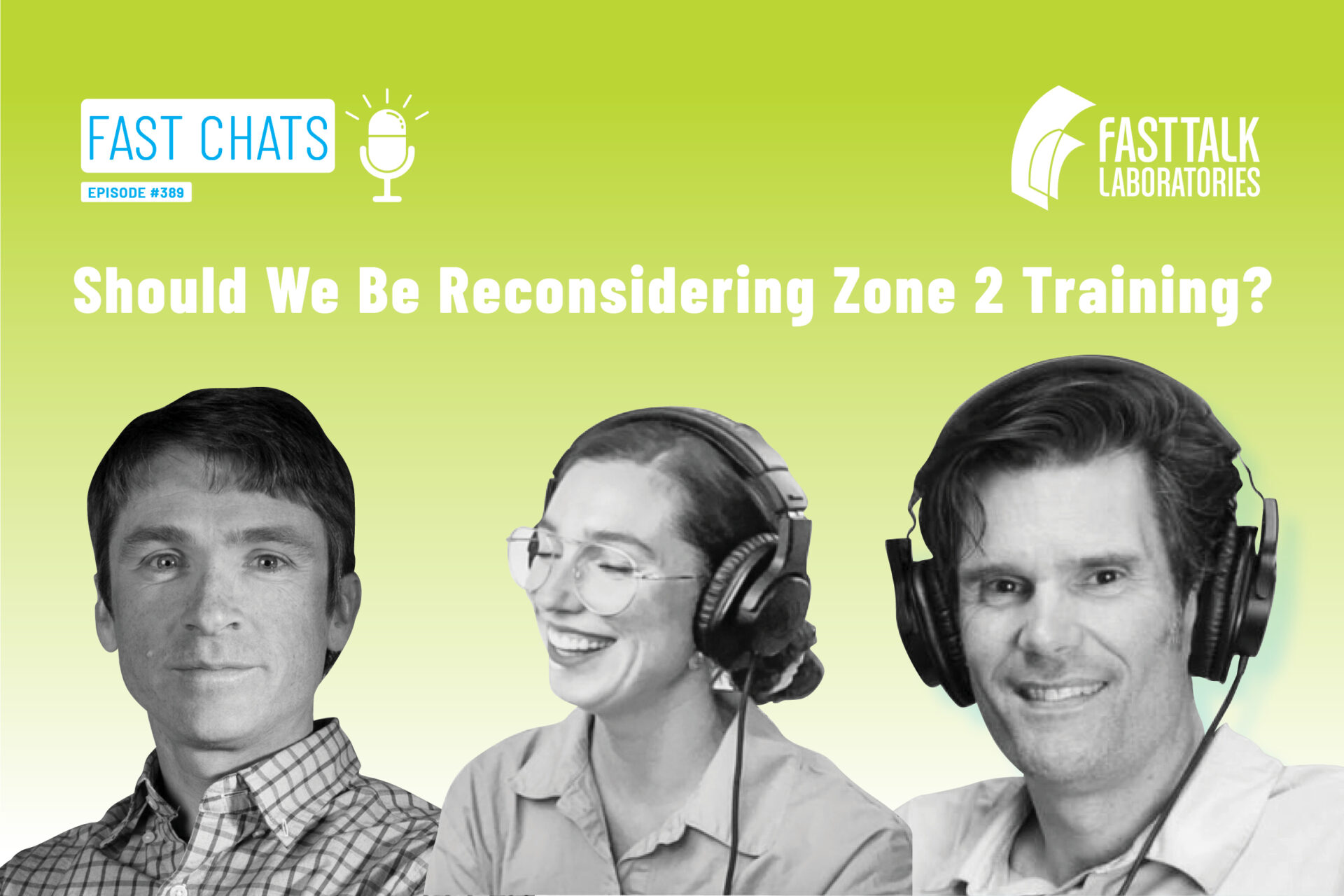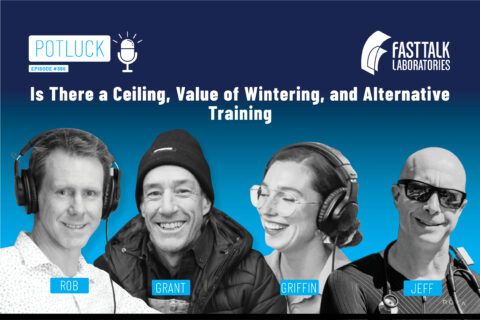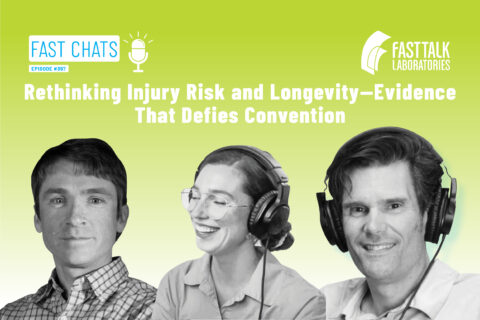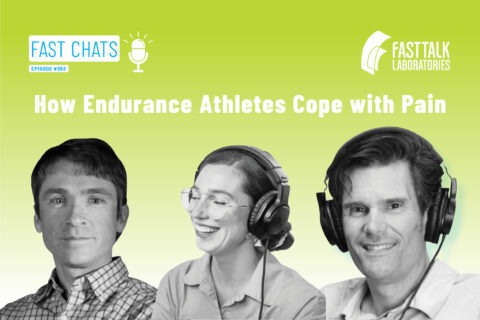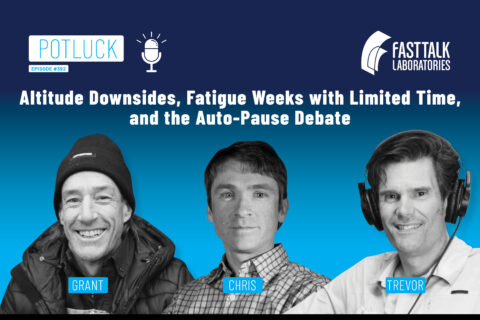Zone 2 training has become all the rage, but a 2025 review is taking a step back and questioning whether it really produces the gains we thought it does.
Episode Transcript
Chris Case 00:05
Hey there. Welcome to another episode of fast talk. Your source for the science of endurance performance today, it’s a fast chat conversation in which we discuss two studies that are questioning the science of zone two training, while elite endurance athletes have known about it for a long time, zone two training has taken the entire endurance sports world by storm in the last decade, and it hasn’t stopped there. Now, popular social media influencers and podcasters are promoting it as the best path to health for the general population. There are many ways to define zone two in simple terms, it’s training just below our first lactate threshold. Think of it as a slightly uncomfortable pace or wattage that can be held for hours. Top researchers such as Dr Paul Larson and Dr John Hawley have published detailed papers explaining how zone two training benefits us and increases our mitochondrial density by promoting a critical messenger called PGC one Alpha, their detailed explanations had long been considered the accepted science, that is, until a review published in June 2025 entitled Much Ado About zone two. Said, hold that thought. This particular review focused on whether zone two training was beneficial for the general population, the conclusion was that for people looking to train a few hours per week for health benefits, high intensity still provides much more bang for their buck. But the review didn’t stop there. It went further to challenge the previously accepted science. It was established that zone two training triggers PGC one Alpha through the calcium calmodulin pathway in high intensity through the amp ATP pathway. The review looked at the literature on both and ultimately concluded that we may have it wrong, even in trained athletes. They found high intensity work seemed to act on both pathways, while zone two training may have minimal impact on either. As part of their evidence, the Much Ado review cited a 2022, paper multiple times that one entitled impact of altered exercise volume, intensity and duration on the activation of AMPK and calcium MK two and increases in PGC, one, alpha, mRNA. This second paper also looked at the effects of zone two training and high intensity training on these two critical pathways. However, it came to a different conclusion, stating that we don’t have enough research on zone two training to draw conclusions, and even cautioned against over inflating the importance of high intensity training. This was a different conclusion from the 2025 paper, which is fascinating, as both papers share an author. So in this fast chat episode, we’ll give our assessments of both papers, explaining where we agree and where we have issues. But perhaps the most important message we’ll discuss is that we always have to remember that no science is ever fully resolved. It is always more complex than we think, and it is important to never take even a good idea and apply it to everything and everyone. So get ready to decide if you want to go hard or if you want to go easy. Let’s make you fast. Trevor. You’re looking so very happy today, giddy. You’ve just read some studies that blew your mind, in a way. They’re biochemistry, so look at you. You can’t stop
Griffin McMath 03:29
smiling. You’re a candy store. Such a good mood, right?
Chris Case 03:33
But you can’t be too long winded today. It’s complicated. It’s complex science, but
Trevor Connor 03:40
I am well aware of the fact that on this episode, you’re going to be telling me to shut up a lot. Excellent. You have my full permission. Chris is not going to do it politely. Griffin, you might be more polite. I’ll try, but I’m going to be told to shut up a lot in this episode. Very good. I will say, though this is a what we are thinking about episode. I am really thinking about this.
Griffin McMath 04:02
Well, let’s dive into what you’re thinking about. So zone two has been everywhere lately, and when I say lately, it really has never gone away in conversation. But recently, there have been some podcast interviews on zone two, and you’ve mentioned Trevor even seeing this wave of interviews and coverage, especially in this past year. So I’m curious with this first paper, why this paper and why did you choose to tackle it now?
Trevor Connor 04:28
So this paper just came out in June of 2025 and it has been getting a lot of traction, a lot of interest. Has been getting a lot of debate as well out on social media. The short title is much ado about zone two, which is kind of a fun title, continuing a narrative review, assessing the efficacy of zone two training for improving mitochondrial capacity and cardiorespiratory fitness in the general population.
Chris Case 04:58
Yes. Continue. Yeah. Yeah,
Trevor Connor 05:00
I’m already I’m just reading titles, and I’m already killing so the short of it is, zone two has become really popular. It got popularized with endurance athletes. Somebody will probably argue with me on this, but I really see Dr Sam Milan as the one who defined this and really pushed this and showed benefits with this. And what you are seeing now is it has gotten out into the public, and they even talk at the start of this paper about influencers have jumped on board this. And now there’s this feeling that zone two is the way to health, the way to fitness. We should be doing a ton of zone two. I know Dr Peter Attia has talked a lot about it, and this paper is basically saying, Hold up, wait a second, yeah, is it really the best way to health? Is it really the best way to fitness? Is it right to be telling people you should just be doing zone two all the time?
Griffin McMath 05:58
So many questions in one though, there’s so many different audiences or populations you’re talking about who have different metabolic needs and therapeutic interventions depending on the goal, right? Yeah, so right away, I think you talked about this earlier when you’re preparing for this episode. Who is the population they talk about at the beginning, and how does that change partway through the paper?
Trevor Connor 06:19
So they say it right in the title. They’re talking about the general population. This study was done up in Canada, and the read author is Christy storrowschuk.
Chris Case 06:27
I think that’s a decent pronunciation. Yeah, we’ll go with that.
Trevor Connor 06:31
I’m sure somebody out there just cringed at that pronunciation, but that’s what we’ll go with. I actually heard her on Dr Larson’s podcast, and it was a great episode. I sent him an email right afterwards and said, You know, I really enjoyed that, where they had this conversation about, have we gone too far with zone two? And she gave a lot of her background, which was really interesting. So I’d recommend, if anybody finds this interesting, we’re doing a short conversation, go check out that podcast. Yeah, so the paper really starts focusing on sedentary, unfit populations, and that’s who they’re really trying to talk to, though, I did find it interesting through the paper, they really just kind of move away from that population and just talk in general about, Are there benefits to zone two training? So the focus here is on our mitochondria, because we know that mitochondria density, mitochondrial health is important, both to our general health and to our aerobic fitness. So they really just go into this. Does zone two training really help mitochondrial biogenesis?
Griffin McMath 07:37
Yeah, we talked about this terminology and definitions are so important in both of these papers. So when we talk about sedentary and unfit, we’re really talking about those who are metabolically impaired. So in case you’re just thinking fit versus athlete or not, those who are metabolically impaired.
Trevor Connor 07:52
Yep, and look, I will tell you part of the reason I’m really smiling, I want to take a quick step back before we dive into either of these two papers we’re going to talk about today. They really showed something that I love, or two things that I love. One is and forgive me, I’m going to quote Dr Seiler for this. I remember seeing Dr Seiler at a big conference presentation where everybody at this round table were asked a question, and everybody was trying to find an answer to it, and they got to Dr Seiler, and his answer was, we have to be humble and recognize there’s more about physiology that we don’t know than we do know. And I think both of these papers really emphasize that, because big names in exercise physiology have written very detailed papers on the two pathways we’re about to talk about, and we’ve really kind of accepted, here’s the way it works. And these two papers are going no you know what? We’ve accepted for 10 years. It’s more complex than that, and we don’t fully understand. So I love that about both of these papers. But the other thing that these papers raise is you have to be so careful about the details you use, because depending on the how you look at the details, you can draw very different conclusions. And as we dive into this paper, this is going to be my one criticism. I think they got some of the details wrong and didn’t recognize that. And ultimately they have a criticism what’s happening right now, but fall into the same trap,
Griffin McMath 09:22
and one of the first details is right in the name of the paper, it’s how they define zone two, right, right? So what’s the difference that you’ve seen here versus what you might have seen in other literature, or even from an exercise physiologist?
Trevor Connor 09:37
So at the top of the paper, they do define zone two correctly, which is typically defined as exercise below LT one. It’s right below LT one. Yeah, as I said, zone two. There is a zone one below that. And as they go through the paper, they lose that distinction. And they, multiple times, talk about the percentages of vO two, max that they would define as zone two. So, and I would love for somebody to counter me on this, but I don’t agree at all with their definition. Yeah, at one point late in the paper, they define zone two as below 45% of vO two Max. That’s not even walking pace. I looked at that in terms of heart rate and other metrics, did the calculations, and I’m like, yeah, if I went out for a walk, I would be above this. Now they are saying talking about sedentary populations, and yes, zone two is going to be lower in a sedentary population, but I did look into this. You know, what’s the common definition? And even in a sedentary population, it’s highly individual, but they’re generally going to put zone two closer to 65% right? And in a trained population, they’re going to put it as high as 80% and they do multiple times in the paper, talk about research that was at 60% of vO two Max, and they state that’s above zone two. And I fully disagree with them on that. And that’s important, because there are points when they reference studies where training was done at 65 70% of vO two Max, and they actually call that high intensity training, right? And show benefits of that, and use that as an argument for why high intensity training is far better than zone two, where I was looking to go. Yeah. No, that zone two training.
Griffin McMath 11:17
Yeah, right. Okay, since we’re diving into the paper. The paper spends a lot of time on AMPK and PGC, one alpha can we break down for the listeners what those molecules do and why they’re considered so central to mitochondrial biogenesis? Oh, boy.
Trevor Connor 11:33
Okay, let’s see if I can do this in not half an hour. So you got two minutes. I’m gonna give a very simple explanation. And look, I know Dr Larson listens to our show every once well, so I cringe whenever I simplify these things, because I know somewhere he and other people are listening to this and going, Ah, Trevor, come on. It’s not that simple.
Chris Case 11:51
All of this is not that simple. That’s kind of one of the points we’re trying to make, which
Trevor Connor 11:55
is a good point. So I’m going to give a very simplified explanation, but there’s a couple things you need to know about. So when you are talking about mitochondrial biogenesis, so seeing adaptations in your mitochondria, there are multiple pathways that promote that ultimately, they all impact something we talk a lot about on the show PGC one Alpha. It is considered the master regulator of mitochondrial biogenesis. And even that’s a simplification, there are other ways, but we’re mostly focused on PGC one alpha and what has been identified. And for anybody who’s interested, we did an episode. It was number 271, on the work of Dr John Hawley. We talk about a paper that he wrote where he talks about the four things that promote PGC, one, alpha, both of these papers focus on two of them, which is what most of the exercise physiology research focuses on. One pathway. Is this, A M P, A M p, k pathway? So I’m gonna try to explain this as simple as possible. But all pathways, there’s multiple, multiple steps, cascade. It is a cascade. So what you have happen is in the muscle cells, you see an increase in amp ADP, that then triggers something called AMPK. AMPK is then one of the regulators of PGC, one alpha. So an AMPK senses higher amp higher ADP. It says, okay, need to do something. And then it goes and promotes PGC, one alpha. And you see an increase in PGC, one alpha in the cell. Very simplified, but hope, did that make sense? Yes, of course. So that’s your cascade. There’s another cascade in cells. You constantly see a release of calcium into the cytosol, calcium ions, calcium ions, you will see often after exercise, calcium remain elevated when that gets elevated. So this is the calcium commodulin pathway. You see something called CA, MK two get activated. And same thing as with a m, p K, C, A M k2 they both have that k in it. They’re Kinesis, yep, C, A M k2 then goes and promotes PGC, one, alpha. So what we’re trying to look at in the research is both what causes these cascades, and also, do you see an effect all the way down the pathway, ultimately to PGC one, alpha mitochondrial biogenesis, the belief, what’s been written about a bunch is ultimately the AMPK, I’ll just simplify to that pathway is promoted by high intensity work. And this calcium commodulin, or the CA, MK two is promoted by long, slow endurance training, and that’s where zone two comes in, right? And what we’ve said a bunch of times on the show is they’re additive. So you need the intensity, you need the long, slow you need to activate both pathways, and that’s where you’re going to see the most benefits. And. Basically what both of these papers do is say, yeah, not that simple,
Chris Case 15:03
right? But do they also make the mistake of going too far and saying something that is a bit counter to kind of the message they are trying to attempt to
Trevor Connor 15:12
say, I would say personally, and this is where you’re getting my opinion. And we’ll dive into this, and I’ll give you my explanations why the zone two paper goes too far. Well, I fully support the main message you’re trying to convey. I think they made some big mistakes. You point out something really interesting, which is the zone two paper. The final author is the lead author on the other paper, right? But interestingly, the papers say very different things. And the second paper, which I found reading the zone two paper. I actually have no issues with it, but I find it actually counters the zone two paper. So it was a very interesting that you have a lead author who’s on both of those papers, and would love to talk with that lead author and go your first paper kind of contradicts the zone two paper. So what happened? I would have thought there
Griffin McMath 16:00
would have been an acknowledgement of that. If I had been on both papers and I had been the lead on the other, I would have wanted that to be acknowledged.
Athletica.ai 16:09
Athletica is trusted by endurance athletes and coaches around the world for one reason, it works built on the foundations of sports science. Our adaptive AI platform supports your training, not with hype, but with real evidence. Go try it yourself@athletica.ai and use the code fast talk to get 15% off a six month subscription. And for coaching businesses or platforms interested in AI powered training under their own brand, we’d love to talk.
Chris Case 16:39
Do you want to go into a little bit more detail about what this contradiction is and how it comes to be in these two papers. Oh, you know, I want to
16:48
that is the question.
Trevor Connor 16:52
Well, let’s start with the zone two paper. Again. Fully agree with their message. What they say from the outset is zone two has become incredibly popularized, and now people are being told, just do zone two, particularly sedentary populations. They’re only training three, four hours a week, and you’re going to see the most metabolic health gains. And they’re saying, This is too far. The evidence isn’t there, right? And we would agree with that. I’m not going to argue with any of that, and I will even go as far as to say, I agree, when somebody is training three, four hours a week, and they are doing this for health, there is a lot of evidence that you are going to see better gains from doing more intensity. So I’m not going to argue with as a matter of fact, we cited a paper, or talked about a paper a couple episodes ago that looked at the impact of training on longevity and did show that you saw better improvement in the markers of longevity from high intensity than you did from long, slow endurance. And I said, you know, I was a betting man. I would have lost that bet because I would have said otherwise, yeah, that paper wasn’t looking at endurance athletes. It was comparing endurance athletes as strength athletes. So that surprised me a little bit. So yeah, I’m not gonna argue with that point at all. What I have personal issues with, and I don’t wanna sound too argumentative when I listened to the lead author on Dr Larson’s show, she kind of took it a step further and started saying, show me gains of zone two. I just don’t see the gains of it. And they very clearly, in this paper, tried very clearly make the argument that actually high intensity promotes both the AMPK and the calcium commodulin pathway. And there is no evidence that zone two really promotes either, you know, again, it’s nuanced. They do talk about, yes, zone two seems to help fatty acid oxidization, so you’re going to use more fat for fuel from zone two training. But the rest of it, they really said, yeah, you just, you see more benefit from high intensity. And I did hear her on Dr Larson’s show, really kind of pushing on the why bother doing zone two?
Griffin McMath 19:02
I think what’s important is even taking a step back. And Chris, you’ve been reporting on endurance sports for a while, and why that conversation seems very peculiar, or why that statement seems so peculiar now in 2025
Chris Case 19:16
Yeah, well, this gets into sort of the and I know Trevor’s gonna talk more about this, the lack of evidence, it should not lead you to conclude that it doesn’t have a basis. But it also is, if you’ve ever trained for an event, if you are an athlete that does bike races, running races, whatever triathlons, you know that it’s the combination that you need to get to your best performances. You can’t just put everything in one bucket or the other bucket. And she’s sort of suggesting, like, why would anybody do zone two? And that is a confounding statement in a way.
Trevor Connor 19:55
And look, I’ll give them credit. They keep some of the nuance, but yeah, that is the overall message. Is they are starting by saying we’ve gone too far towards zone two. Everybody’s promoting just zone two all the time. That’s a mistake. We need high intensity. 100% agree. But then if you read the paper and listen to some of the interviews, they kind of go to the opposite end of why would you bother doing zone two? And this is where I really struggle with the paper, because in their conclusions, they literally make this statement again. This is going back to you got to be really careful about what you state in research, because they make a statement that is a very strong statement, and then literally contradict themselves in the rest of their conclusions. So the statement they say up at the front further, the majority of the available evidence argues against the ability of zone two training to increase mitochondrial capacity. I can’t back that statement from their study, yeah, because they’re basically saying the evidence is against zone two. That is different from saying the research hasn’t been done exactly, yeah, so they make that statement. Then in the rest of the conclusion say many gaps remain in our understanding of whether and how mitochondria adapt to zone two training. Then a major finding of the current review is that few studies have explicitly examine the effect of zone two training. So they start by saying the bulk of the evidence shows no benefits to zone two, and then they go on and say there’s no research on zone two. Yeah, those fundamentally contradict each other, and we’ll get to this in the second paper. The second paper just says there’s very little research on zone two. We just don’t know. And I think that is a completely fair statement that, yeah, we have made the assumption that zone two really hits this calcium commodulin pathway, and we don’t have enough evidence to say, yeah, absolutely conclusive. We’re not there. 100% agree with that. But I think this paper drawing these conclusions, it just went too far to say, yep, you really see all the gains from high intensity, and the evidence is against zone two. I think that’s where they got to, and they don’t make their case. Yeah, I think they make some mistakes, one of them being that you can say the evidence isn’t there, but you can’t say that as proof that zone two is not
Chris Case 22:18
beneficial. Does this also open the door for criticism or definition about duration here, because that’s a substantial element to these studies.
Trevor Connor 22:28
So that’s another one that you see in both papers, and I think the second paper actually does a better job of recognizing this. But duration is important, and the literature made this mistake 1520, years ago, when they looked at intensity versus long slow distance, and really then pushed intensity. And when they were talking about long slow distance, they were talking about short duration. And both of these papers, most of the research they cite on long duration is 90 minutes or less. As a matter of fact, multiple times they cite papers that people are training in zone two for 30 minutes. And again, if you’re talking about a sedentary population, 90 minutes might be considered long. But you know, even when I’m working with brand new athletes and we’re saying we’re going to build your aerobic fitness, I would still say 90 minutes is the minimum, right? You’re not going to have them do a six hour ride, but two, two and a half, three, yeah, yeah. So that’s important. There are many times in the paper where they go, we see no benefits of zone two, and then you dive into the study that they’re citing, and it’s 30 minutes or 45 minutes at 60% and you go, that’s a recovery, right? But it’s important to point out that we have been just talking about this 2025 paper that looks at the potential benefits, or lack of benefits, of zone two training in a general population. But this is where it gets interesting. So there’s that other paper, and its title is a mouthful, so maybe we’ll just refer to it as the 2022 paper. So it was really read it. Read it. Are you gonna make me do this?
Griffin McMath 24:06
Forget the whole question. By the time with the same enthusiasm,
Trevor Connor 24:09
impacts of altered exercise volume, intensity and duration on the activation of AMPK and CA, MK two and increases in PGC, one, alpha mRNA, so they’re talking about these pathways as well. One thing I am going to mention. You heard that in the title volume, intensity and duration. This got confusing. I’ve never seen this done before. Duration is what they are using to describe when you do a long workout. Volume, to the best of my ability, that’s what we would be referring to as work or training stress, so they see volume as a function of intensity and duration. I see, okay, so intensity can contribute to volume, duration can contribute to volume. So I would call that training stress, right? Or workload, workload, yeah, and it gets confusing as you read it, because I keep seeing volume and duration. Okay, which that is confusing, okay, but here’s where it gets interesting, because I found this paper reading the zone two paper. It was referenced at several key points. It was referenced when they made their argument that intensity is better than zone two, producing mitochondrial benefits. And this was their reference. It was also their only reference when they made the case that intensity can promote both the AMPK pathway and the calcium commodion pathway. So I was like, got to grab this paper. It seems Central. And what I found really surprising is when you read that paper, it is, in many ways, the best argument against what it’s being cited for. So these are quotes right out of that 2022 paper, the first one, this is in their introduction, and basically the warning they give in the introduction, we will attempt to highlight the studies that have isolated the effect of exercise intensity by matching total training volume, and we’ll discuss the complications of interpreting studies where both intensity and volume are augmented as evidence supporting the superiority of intensity for activating mitochondrial biogenesis. So they’re kind of warning about saying intensity is superior. Again, it was the only paper cited as their evidence that intensity promotes the calcium commodulin pathway. Direct quote out of the paper. The bulk of the literature does not support an intensity dependent activation of CA, MK two. And then finally, in their conclusions. Again, this is a paper cited to say intensity is better than duration or volume or zone two. This is their conclusions. We are unfortunately unable to comment with certainty regarding which of intensity or duration are the better means of augmenting volume so training stress, when targeting optimal increases in exercise mediated mitochondrial biogenesis. So their conclusion is, we can’t say which is better.
Griffin McMath 27:06
I think this is one of the reasons why I struggle with the first paper. I just didn’t feel like the methods were solid, not just from defining the terms, but the conclusion is propped up on a fallacy, plain and simple. It’s interesting. So it is that’s a logical fallacy.
Trevor Connor 27:22
So I would love that author that’s on both papers, yeah, to go and talk with him and say, Why are you citing your own paper to make a case that in that paper you say you can’t make you actually argue against
Chris Case 27:37
you seem to like this second paper more in the message being it’s complicated, some of the accepted beliefs or simplification of pathways are a little bit too simplified, if you will. And this goes into more of the nuance of that.
Trevor Connor 27:55
Yeah, I love this paper. I have no issues with this paper. I love ones that get into the complexity, and it is basically a response to a pretty widely held and accepted belief. And I am one of those people that fully accepted this belief, that long, slow volume zone two training acts through this calcium commodulin pathway, high intensity acts through the AMPK pathway, and that they’re additive, and this paper said, Hold on, let’s see if there’s actually any research to support this.
Chris Case 28:26
Yeah, and not to defend anybody, but we’re talking about what we’ve already described as extremely complicated physiology. Someone like Dr Seiler, who is steeped in this stuff on a daily basis, is saying we don’t know as much as we think we know. There’s so much more to learn. Sometimes we have to simplify things so that we can have a conversation about this stuff. Sometimes you have to simplify things in order to make it digestible for lay people out there who aren’t biochemists. However, sometimes you can go too far.
Trevor Connor 28:59
You can and I think this paper was a really good reminder, for those of you who are steeped in this, be careful about what you say, and I don’t think it made some of the mistakes that I saw in the first paper. They actually talk in here about one of the major issues is we have almost no research on zone two training, on long duration, and they don’t say so that is evidence that it doesn’t work. Yeah, they are saying, basically, we can’t draw conclusions more importantly. And, you know, I would love it if this is where we finish out. Because again, I think this is the ultimate mistake of the first paper. They give the warning of, be careful about over inflating high intensity, because there is a ton of research on high intensity.
Chris Case 29:47
Yeah, there’s a bias towards it because it’s easier to do, right?
Suzy Sanchez 29:51
Yeah. Hi listeners. This is Susie Sanchez from USA Cycling for over a decade. Fast talk podcast has brought the most interesting echo. Experts from the world of endurance sports into a conversation about your training, if you like, what you hear on fast Talk what about becoming a certified coach? USA Cycling offers courses for new coaches produced with expert help from fast talk labs. Learn about becoming a certified coach at USA cycling.org backslash coaches,
Trevor Connor 30:18
basically without diving hugely into the details of this paper. They take those two pathways that we just talked about, and they go through the AMPK pathway. So first, what impact do you see on amp ADP, then on AMPK, and then ultimately on PGC, one alpha and mitochondrial biogenesis. They do the same thing with the calcium commoditium pathway. And then they look at both the impacts of intensity and duration. And quite frequently, they just go, there’s no research on duration in this and they recognize this go, lot of the research on duration is actually pretty short. And when they get to that AMPK pathway, they go, when you talk about duration, it actually gets extraordinarily complex. And I’ll give you the very shortened version of this, which I’m glad to see somebody bring up. AMPK is referred to as the energy sensor in our cells. It detects glucose levels in our blood, and then it activates when glucose levels drop. It is also we do know it is activated by high intensity, because when you see amp levels go up, which you see when you do high intensity, that also activates AMPK. But if you’re doing a lot of either hard training, or if you’re doing really hard training, or you’re doing a lot of volume, you deplete your glycogen. When you deplete your glycogen, your blood glucose levels will go down, and that also activates AMPK. So there is a potential for long duration to intact AMPK. But when you’re only doing a 90 minute study at 60% Yeah, you’re not going to deplete your glycogen, right? If you’re a pro going out and doing five hours at 280 watts, you’re going to see some glycogen depletion. You might see AMPK be activated, but that research hasn’t been done, so they’re recognizing all this complexity, and I could go into each but basically where they get to in the conclusions is that high intensity work has at least a small effect on the AMPK pathway, which is pretty consistent with what we’ve been saying and What we’ve been seeing in the past research. The second major point they make in their conclusion is there’s very little research on duration. And again, to their credit, they say this is not evidence against we just don’t know. But they fairly say that we can’t conclude that duration acts 100% through this calcium commodulin pathway, like what we have accepted as dogma. There isn’t enough research to back that either, and it’s a really fair point. They don’t have this in conclusions, but I do think they also make the point that it’s not black and white. There’s interesting evidence that intensity can potentially impact both pathways. Clearly impacts AMPK, but can have minor effects on the other pathway. Even on the AMPK pathway, there was some evidence that no intensity doesn’t affect it, and with the little bit of research on duration, there’s potential for it to impact both pathways too. So it’s not this black and white. One acts through this pathway, one acts through that pathway. And I think that’s a really good point to make. Another thing they bring up early on is they’re just looking at these two pathways, but there are two others that we know of impact, PGC, one, alpha,
Chris Case 33:30
there’s so many layers here. That’s how it gets even far more complicated.
Trevor Connor 33:34
And that’s something I didn’t bring up with the zone two paper that I think is really important. Where they make the case, well, we’re not really seeing any benefits of zone two. Well, even if you’re right, even if every bit one of their arguments is correct, they were only looking at mitochondrial biogenesis. And as I said, was really Dr Tom Milan, who, I think, popularized zone two. He wasn’t looking at mitochondria, he was looking at lactate metabolism. And that’s not touched in either of these papers, and that is an important adaptation. So you can’t just say, well, we don’t see benefits to mitochondrial biogenesis, therefore Zone Two is not beneficial. It could have other benefits that they’re not even looking at. And again, this paper recognized that, said we’re just looking at a couple things. There’s a whole bunch that we’re not touching on. And actually just take this a step further. Let’s just talk about mitochondrial biogenesis. So forget all the lactate stuff, as we mentioned. And both papers did recognize this. There are four pathways to promoting mitochondrial biodegenesis, to promoting that, PGC, one, alpha. These papers just talk about two, the calcium module and pathway and the AMPK pathway, and admit they don’t address the other sides. One of the other really important ones is an increase in oxidative stress. Can also promote mitochondrial biogenesis. And to give you an idea, we had Dr San Milan on the show where we did an. Entire episode talking about zone two training. This one goes back. This was episode 109, for anybody who’s interested. And we spent a long time on that episode talking about oxidative stress and the fact that when you take elite Elite like Tour de France level cyclists, and you put them even through a huge stage race, you’re actually going to see a decrease in their oxidative stress, where, if you take a far less experienced, far less trained cyclist and put them through less stress, the oxidative damage, the oxidative stress in their body, will become overwhelming. So that’s clearly an important adaptation. And remember this, 2025 paper is looking at mitochondrial biogenesis as a health benefit for the general population. And when you are talking about health benefits, when you’re talking about longevity, one of the big theories of longevity is oxidative stress, that as we get older, our mitochondria doesn’t function as well, and as a result, we start producing more oxidative stress, and that basically ages us. So there’s a pretty good argument that if we can manage oxidative stress, if we can keep those natural antioxidants flowing in the body, if we can keep our mitochondria functioning, well, we’re going to age better and stave off disease. So when they have a paper about mitochondrial biogenesis and the impact of exercise training on that, and we know that oxidative stress promotes mitochondrial biogenesis and is also critical to health and longevity, and that’s not even touched on in the paper, that to me, is a really big hole in the paper. And another reason you can’t conclude, well, there’s no benefits of zone two, because maybe that is where you see the benefits. Maybe that is where you see this general population producing this mitochondrial biogenesis through the oxidative stress pathway. We don’t know, because they didn’t review that part and they didn’t look at those studies. But again, going back to this 2022 paper, they conclude, and this is different from the 2025 paper that we don’t know if intensity or volume is better. So I love this paper that it basically says this is complex. There’s not enough research, we can’t say it is clear cut as we have been making it, and I’m fully guilty of saying it’s clear cut, and there just aren’t that many conclusions we can draw. And we need to do more research on this. So I have zero issues with this review. Think it’s a great review.
Griffin McMath 37:36
So while the first paper you say goes too far, this paper stops at the line that you’re okay with personally? Yes. Okay, so then, what does the athlete do with this information?
Chris Case 37:46
That’s the question that I’ve been waiting whatever, 30 minutes to ask. What?
Griffin McMath 37:51
Not an ounce of sass in that question. As
Chris Case 37:54
a listener out there who just is riding his bike or running and training for an event, what did these papers mean for them?
Trevor Connor 38:03
Well, first of all, I think what’s really important is because this zone two paper has been getting so much press and has been really important. I think it’s very important to understand what you can draw from this paper and what you can’t. I agree 100% with the argument it’s making that, particularly in sedentary individuals saying zone two all the time is the way to go is a stretch too far. But I think we also have to be careful about what I heard in that podcast of going back the other way, and particularly because I am seeing an argument being made by this paper and the authors that was made 1520, years ago. That was a mistake, because we didn’t look at the shortcomings in the research, which was, again, there’s a ton of research in high intensity. We see the benefits. There isn’t really any research on true long duration zone two training, therefore zone two training isn’t beneficial. High intensity is beneficial. So you should be doing high intensity all the time. The research community made that mistake 1520, years ago, and I’m seeing them literally cite the same studies from back then making that same argument. You go, No, we realize that was a mistake. Then let’s not make that mistake again. So you’re probably hearing about this in social media, and I think, yep, their argument against doing zone two all the time spot on their argument that zone two isn’t beneficial and you should be doing all high intensity, just as big a mistake. I would say that is, to me, the biggest take home. And I would say, again, it’s balance. It’s a question of, where is that balance? And I think again, going back to Dr Seiler, we got to be humble and say there’s a ton about physiology we don’t understand. So yes, we have to rely on experience. And again, when I saw the interview with Dr Larson, when he brought up experience, that was kind of that doesn’t count, show me the research. And we just can’t do that. We can’t as research. Say if it isn’t in the research, it isn’t real
Chris Case 40:02
to that point, this is maybe a tough question to answer if you’re designing the next study based on what you want to know. What does that look like?
Trevor Connor 40:12
Both these papers made that point really well, which is, we’ve got to do the research on true zone two training with true duration part of the mistake, you know, there’s a lot of studies you can find, circa 2005 2010 that literally have in the titles, high intensity training is more effective than long, slow distance. And when you dive into the paper, they were matching for work. So they’d have them do 22 minutes of intervals and then a 40 minute ride at 60% which is not a training ride, yeah. So we need to do the research where we go. We’re going to have people go out do 456, hours at a true zone two. And if you’re talking with a sedentary population, no, not six hours. Find a different duration. If you’re talking about trained athletes, yeah, you need that longer duration, and it needs to be more than a four week study. It needs to be a long term study. That’s what I would love to see. Can that be funded? Can you conduct that study? It’s really difficult, which is why it hasn’t been done. But we’re not going to have the answers until that is done,
Griffin McMath 41:15
and you demand those answers so that we can come back on here and you can get giddy all over again. You know,
Trevor Connor 41:20
I’m going to go to some great business advice I was given when I started this business, which was, be careful about waiting to make decisions until you have all the answers, because you will never have all the answers. You have to take the answers that you have, which is never perfect, and then make a decision and then adjust as you go. And this to me, this zone two versus high intensity debate, we know we’re really lacking the research. I don’t think we’re going to have those answers anytime soon, and we can’t wait to design training plans until we have those answers. So we got to take imperfect information and make the best decisions that we can’t, and that is why we can’t put down experience.
Chris Case 42:04
It’s interesting, like a researcher thinks that there’s only one laboratory, but the coaches and athletes know that there’s another laboratory. They’re in it every day, and you can’t discount that, because they learn things, and they might be ahead of the curve here at what
Trevor Connor 42:22
works either way, we want coaches and researchers to work together, and this is where you get coaches to stop talking to researchers. When researchers get caught up and well, experience doesn’t count, it’s only what’s measured in a lab. And they go, here’s what the research shows, and you need to be doing high intensity all the time. And the coach goes, I’ve been coaching athletes for 20 years. I’ve coached Olympic champions, Tour de France athletes, exactly. That ain’t the way at work. And the researcher goes, that’s just experience. You’re just talking out your butt. Yeah? That’s when coaches go, Yeah, I’m going to stop talking to you, yeah. So there needs to be that conversation. There needs to be the respect on both sides. So there’s huge value to the research, but researchers need to have that bit of humility of saying there’s a ton that we can’t research or that we just don’t know. So we got to go with experience.
Griffin McMath 43:09
That was another episode of fast talk. The thoughts and opinions expressed on fast talk are those of the individual subscribe to fast talk wherever you prefer to find your favorite podcast. Don’t forget, we’re now on YouTube, as always, be sure to leave us a rating and a review. To learn more about this episode, from show notes to References, visit us@fasttalklabs.com and to join the conversation on our forum. Go to forums.fasttalklabs.com for Chris case and Trevor Connor, I’m Dr Griff McMath. Thanks for listening. You.
